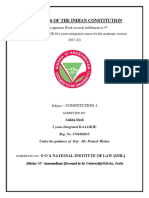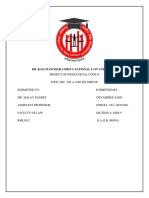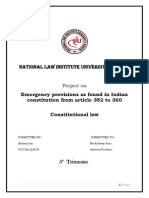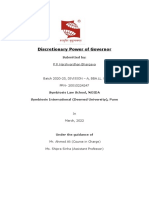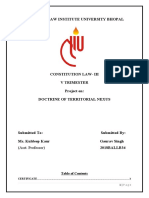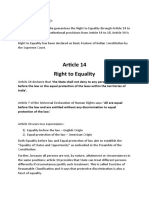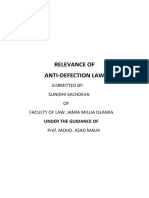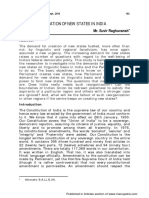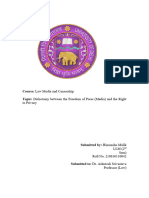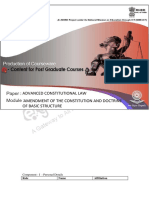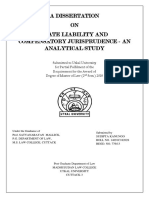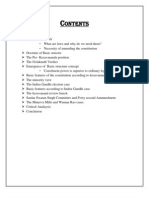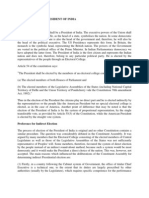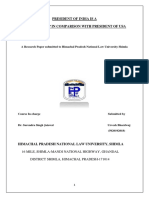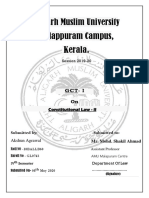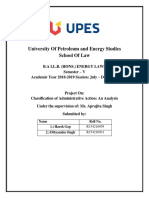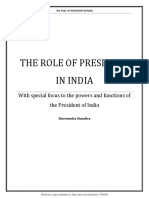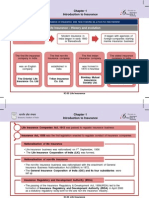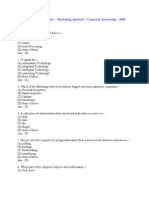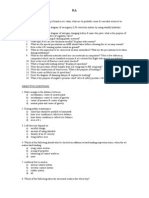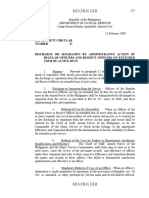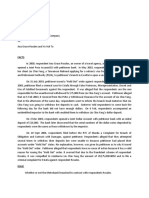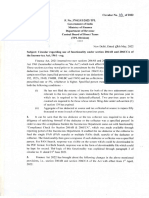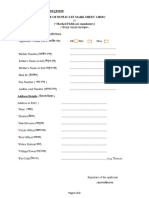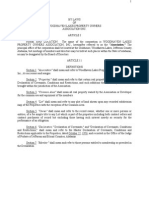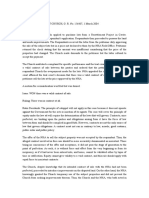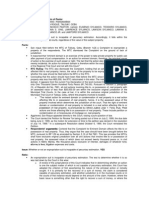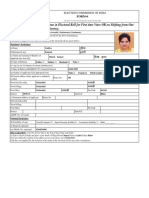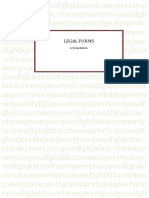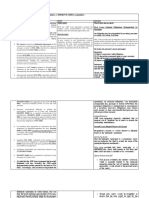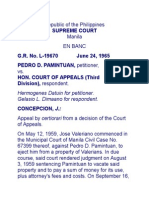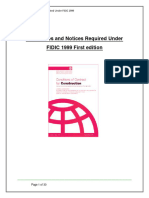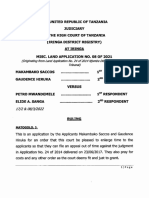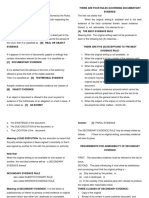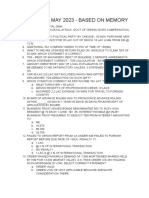100%(5)100% found this document useful (5 votes)
6K viewsNature of Indian Constitution
Nature of Indian Constitution
Uploaded by
Gaurav SharmaThe Indian Constitution is primarily a federal constitution despite some unitary features. It distributes powers between the central and state governments but also grants some centralizing powers to preserve national unity. While some argue it is "quasi-federal", others say its predominant federal character means it can be considered a federal constitution. Some provisions that challenge its federal spirit include the central government's power over state governors, laws on state matters in some cases, altering state boundaries, and taking control of states during emergencies. Overall the federal structure has been upheld by the Supreme Court.
Copyright:
Attribution Non-Commercial (BY-NC)
Available Formats
Download as TXT, PDF, TXT or read online from Scribd
Nature of Indian Constitution
Nature of Indian Constitution
Uploaded by
Gaurav Sharma100%(5)100% found this document useful (5 votes)
6K views2 pagesThe Indian Constitution is primarily a federal constitution despite some unitary features. It distributes powers between the central and state governments but also grants some centralizing powers to preserve national unity. While some argue it is "quasi-federal", others say its predominant federal character means it can be considered a federal constitution. Some provisions that challenge its federal spirit include the central government's power over state governors, laws on state matters in some cases, altering state boundaries, and taking control of states during emergencies. Overall the federal structure has been upheld by the Supreme Court.
Copyright
© Attribution Non-Commercial (BY-NC)
Available Formats
TXT, PDF, TXT or read online from Scribd
Share this document
Did you find this document useful?
Is this content inappropriate?
The Indian Constitution is primarily a federal constitution despite some unitary features. It distributes powers between the central and state governments but also grants some centralizing powers to preserve national unity. While some argue it is "quasi-federal", others say its predominant federal character means it can be considered a federal constitution. Some provisions that challenge its federal spirit include the central government's power over state governors, laws on state matters in some cases, altering state boundaries, and taking control of states during emergencies. Overall the federal structure has been upheld by the Supreme Court.
Copyright:
Attribution Non-Commercial (BY-NC)
Available Formats
Download as TXT, PDF, TXT or read online from Scribd
Download as txt, pdf, or txt
100%(5)100% found this document useful (5 votes)
6K views2 pagesNature of Indian Constitution
Nature of Indian Constitution
Uploaded by
Gaurav SharmaThe Indian Constitution is primarily a federal constitution despite some unitary features. It distributes powers between the central and state governments but also grants some centralizing powers to preserve national unity. While some argue it is "quasi-federal", others say its predominant federal character means it can be considered a federal constitution. Some provisions that challenge its federal spirit include the central government's power over state governors, laws on state matters in some cases, altering state boundaries, and taking control of states during emergencies. Overall the federal structure has been upheld by the Supreme Court.
Copyright:
Attribution Non-Commercial (BY-NC)
Available Formats
Download as TXT, PDF, TXT or read online from Scribd
Download as txt, pdf, or txt
You are on page 1of 2
Q. What is the nature of Indian Constitution?
On what grounds is its spirit of f
ederalism challenged? Mention its important features.
Typically, democratic constitutions are classified into two categories - Unitary
and Federal. In a unitary constitution, all the powers are concentrated in a ce
ntral authority. The states or the constituents of the country are subordinate t
o such central authority. In a federal constitution, powers are distributed amon
g the center and the states. States are not subordinates of the center. Accordin
g to Prof. Wheare, the constitutions of USA, Australia, and Switzerland are prim
e examples of a federal constitution.
Dr. Ambedkar has categorically said in Constituent Assembly discussions that not
withstanding certain provisions that centralize the powers, Indian Constitution
is essentially federal. Prof. Wheare and some other academicians, however, are h
esitant in calling it a federal constitution and prefer to term it as "quasi-fed
eral" or "federal with strong centralizing tendency".
Though, it should be noted that even prof. Wheare accepts the existence of certa
in provisions in the American constitution, such as dependence of Senate on Stat
es, that are contrary to federal character. However, he says that while the prin
ciples of federalism should be rigid, the terminology of "federal constitution"
should be wide. A constitution should be called federal if it displays federal c
haracter predominantly.
The following are the defining features of federalism.
1. Distribution of Powers between center and states.
2. Supremacy of the Constitution.
3. Written Constitution.
4. Rigidity of the Constitution.
5. Independent Judiciary.
All the above characteristics are present in the Indian Constitution. However, t
here are certain provisions that affect its federal character.
1. Appointment of the Governor of a State
Art 155 and 156 provide that the Governor, who is the constitutional head of a S
tate, is to be appointed by the President and stays only until the pleasure of t
he President. Further, that the Governor can send the laws made by the state for
assent from the President, who can veto the law.
It should be noted that Governor is only a ceremonial held and he works on the a
dvice of council of ministers. In past 50 yrs, there has been only one case (re
Kerala Education Bill), where amendments to a state law were asked by the center
and that too after the opinion of the Supreme Court. Thus, it does not tarnish
the federal character and states are quite free from outside control.
2. Power of the parliament to make laws on subjects in the State list.
Under art 249, center is empowered to make laws on subjects in the state list. O
n the face of it, it looks a direct assault on the power of the states. However,
this power is not unlimited. It is exercised only on the matters of national im
portance and that too if the Rajya Sabha agrees with 2/3 majority. It should be
noted that Rajya Sabha is nothing but the representative of the states. So an ap
proval by Rajya Sabha means that States themselves are giving the power to the c
enter to make law on that subject.
3. Power to form new states and to change existing boundaries
Under Art 3, center can change the boundaries of existing states and can carve o
ut new states. This should be seen in the perspective of the historical situatio
n at the time of independence. At that time there were no independent states. Th
ere were only provinces that were formed by the British based on administrative
convenience. At that time States were artificially created and a provision to al
ter the boundaries and to create new states was kept so that appropriate changes
could be made as per requirement. It should be noted that British India did not
have states similar to the States in the USA.
4. Emergency Provisions
Center has the power to take complete control of the State in the following 3 si
tuations :
1. An act of foreign aggression or internal armed rebellion (Art 352)
2. Failure of constitutional machinery in a state (art 356)
3. Financial Emergency (art 360)
In all the above cases, an elected state government can lose control of the stat
e and a central rule can be established. In the first case, it is very clear tha
t such a provision is not only justified but necessary to protect the existence
of a state. A state cannot be left alone to defend itself from outside aggressio
n. In the third case also, it is justified because a financial emergency could c
ause severe stress among the population, plunge the country into chaos and jeopa
rdize the existence of the whole country. Such provisions exist even in USA. The
second provision is most controversial. It gives the center the power to take o
ver the control of a state. However, such an action can be taken only upon the a
dvice of the governor and such an advice is not beyond the purview of the Suprem
e Court. In a recent case, Supreme court ruled that the imposition of Presidenti
al rule in the state of Bihar was unconstitutional.
Thus, it can be safely said that Indian Constitution is primarily federal in nat
ure even though it has unique features that enable it to assume unitary features
upon the time of need.
Features of Indian Constitution
Constitution was written by a committee headed by Dr Ambedkar. Took 2 yrs, 11 mo
s, 18 days. Adopted on 26th Nov (celebrated as Law Day), enforced fully on 26th
Jan.
1. Longest written constitution - 447 articles, 26 parts, 12 schedules. Origi
nal US constitution had 7 articles and Australia had 128.
2. Establishment of sovereign, socialist, secular, democratic, republic.
3. Parliamentary form of govt.
4. Unique blend of Federal and Unitary features
1. Independent and supreme Judiciary - Keshavand Bharati vs State of Ke
rala & L Chandra Kumar vs Union of India
2. Advisory Jurisdiction of SC - Art 143 - Does not exist in US constit
ution.
3. Rigidity and flexibility
4. Emergency Provisions
5. Single Citizenship
6. Single Electorate / Adult Suffrage
5. Positive Secularism - St. Xavier's College vs State of Gujarat , S R Bomma
i vs Union of India, Aruna Rai vs Union of India
6. Indian Socialism - Combination of Marxist and Gandhian ideology. Right to
work is absent.
7. Economic Democracy
8. Other features
1. Fundamental rights - J Bhagvati in Menaka Gandhi vs Union of India
2. Directive Principles - Unnikrishnan vs State of AP - Directive Princ
iples are as good as fundamental rights.
3. Fundamental Duties
You might also like
- Essential Soft Skills for Lawyers: What They Are and How to Develop ThemFrom EverandEssential Soft Skills for Lawyers: What They Are and How to Develop ThemNo ratings yet
- Contract ms0Document1 pageContract ms0Mark AntoniNo ratings yet
- Right To EqualityDocument18 pagesRight To EqualityRINKU BOTHRANo ratings yet
- Driving Without A LicenceDocument3 pagesDriving Without A Licencermaq83% (6)
- India and Federalism: Holding Together or Coming Together FederationDocument5 pagesIndia and Federalism: Holding Together or Coming Together FederationSachin The GreatNo ratings yet
- It’s Time to Implement the Forgotten Constitution of India for Liberty and DignityFrom EverandIt’s Time to Implement the Forgotten Constitution of India for Liberty and DignityRating: 3 out of 5 stars3/5 (2)
- Powers and Functions of GovernorDocument10 pagesPowers and Functions of GovernorKOTUB UDDIN AHMEDNo ratings yet
- Relationship Between Administrative Law and Constitutional LawDocument3 pagesRelationship Between Administrative Law and Constitutional LawKunal AggarwalNo ratings yet
- Residuary Powers of Parliament of IndiaDocument7 pagesResiduary Powers of Parliament of IndiaLeena SinghNo ratings yet
- Civil Society and Public Grievances ProjectDocument11 pagesCivil Society and Public Grievances ProjectFaizan Ahmad NomaniNo ratings yet
- 131 - Shreya Singhal Case and It's Impact On Indian SocietyDocument13 pages131 - Shreya Singhal Case and It's Impact On Indian Societykratik barodiyaNo ratings yet
- Salient Features of The Indian ConstitutionDocument8 pagesSalient Features of The Indian Constitutionmeghna dhanwnaiNo ratings yet
- Article 13 of The Indian ConstitutionDocument9 pagesArticle 13 of The Indian ConstitutionSaharsshNo ratings yet
- Mohd Hanif Quereshi Vs State of Bihar - Docx Final-2Document15 pagesMohd Hanif Quereshi Vs State of Bihar - Docx Final-2RAJAT PANDEYNo ratings yet
- Article 16 of The Indian Constitution ConstiDocument14 pagesArticle 16 of The Indian Constitution ConstiAnkita Dash100% (1)
- The Icfai University: School of LawDocument16 pagesThe Icfai University: School of LawAyush Kumar SinghNo ratings yet
- Gram Nyayalaya ActDocument15 pagesGram Nyayalaya Actmephistopheles6001100% (1)
- Constitutional LawDocument9 pagesConstitutional LawPriya KushwahaNo ratings yet
- Election Commission of IndiaDocument18 pagesElection Commission of IndiaViren SehgalNo ratings yet
- Constitutional Safeguards To Civil Servants: An Analysis: Dr. Babita DeviDocument10 pagesConstitutional Safeguards To Civil Servants: An Analysis: Dr. Babita Deviashirbad sahooNo ratings yet
- Ipc Final ProjectDocument11 pagesIpc Final ProjectdevashreeNo ratings yet
- Article 352 To 360Document12 pagesArticle 352 To 360Anonymous aheaSN75% (4)
- Research Paper: Year 3 SemesterDocument13 pagesResearch Paper: Year 3 Semesterpriyanka0% (1)
- Constitutional Law ProjectDocument7 pagesConstitutional Law ProjectTurbo TasticNo ratings yet
- Ipc ProjectDocument13 pagesIpc Projectanon_909832531No ratings yet
- Bommai Versus Union of IndiaDocument26 pagesBommai Versus Union of Indiakanishka srivastava100% (1)
- Constitution LawDocument16 pagesConstitution Lawgaurav singh0% (2)
- Introduction:-: Before The Law or The Equal Protection of The Laws Within The Territories of India'Document11 pagesIntroduction:-: Before The Law or The Equal Protection of The Laws Within The Territories of India'AnukritiNo ratings yet
- Relevance of Anti-Defection Law: Submitted By: Sunidhi Sachdeva OF Faculty of Law, Jamia Millia IslamiaDocument15 pagesRelevance of Anti-Defection Law: Submitted By: Sunidhi Sachdeva OF Faculty of Law, Jamia Millia IslamiavidhiNo ratings yet
- Doctrine of Colourable Legislation SeverabilityDocument5 pagesDoctrine of Colourable Legislation SeverabilitysandeepNo ratings yet
- Cooperative Federalism in IndiaDocument5 pagesCooperative Federalism in IndiaAkanksha baibhav100% (1)
- An Analysis of Pre and Post S.R. Bommai Senario With Refrence To President'S Rule in StatesDocument7 pagesAn Analysis of Pre and Post S.R. Bommai Senario With Refrence To President'S Rule in StatesBodhiratan BartheNo ratings yet
- Creation of New States in IndiaDocument9 pagesCreation of New States in IndiaSHAIKH TAJ MOHAMMED100% (1)
- Media LawDocument13 pagesMedia LawHimanshu MalikNo ratings yet
- Project Title: Directive Principles of State PolicyDocument17 pagesProject Title: Directive Principles of State PolicyKamlakar ReddyNo ratings yet
- Constitutional AmendmentDocument17 pagesConstitutional AmendmentVidit HarsulkarNo ratings yet
- Amendment and Basic StructureDocument12 pagesAmendment and Basic StructureSatyam Pathak100% (2)
- Salient Feature of Indian ConstitutionDocument14 pagesSalient Feature of Indian ConstitutionMINNU MINHAZ100% (1)
- Final Project Submitted ON Appointment of Judges To Higher Judiciary With Special Reference To NjacDocument13 pagesFinal Project Submitted ON Appointment of Judges To Higher Judiciary With Special Reference To Njacpragya mishraNo ratings yet
- Salient Features of Indian ConstitutionDocument2 pagesSalient Features of Indian Constitutionvirsing vasaveNo ratings yet
- Issues and Challenges Faced by Indian FederalismDocument7 pagesIssues and Challenges Faced by Indian FederalismAnonymous JdfniItox3No ratings yet
- Constitutional Law ProjectDocument13 pagesConstitutional Law ProjectVipasha VermaNo ratings yet
- Article 12: Scope As Expanded by JudiciaryDocument9 pagesArticle 12: Scope As Expanded by JudiciaryniceidNo ratings yet
- Constitutional Law ProjectDocument32 pagesConstitutional Law Projectbilal khanNo ratings yet
- State LiabilityDocument93 pagesState LiabilitySudipta KanungoNo ratings yet
- The Union ExecutiveDocument44 pagesThe Union ExecutiveMayank GargNo ratings yet
- Khatri Vs State of BiharDocument5 pagesKhatri Vs State of Biharshalin86% (7)
- Doctrine of Basic StructureDocument13 pagesDoctrine of Basic StructureMayank DigariNo ratings yet
- Civil ServantsDocument27 pagesCivil ServantsMayuri Yadav100% (1)
- Election of The President of IndiaDocument16 pagesElection of The President of Indiaatege14No ratings yet
- Preventive Detention ActDocument23 pagesPreventive Detention ActArthi OikawaNo ratings yet
- Legal Methods ProjectDocument22 pagesLegal Methods ProjectBharatSahuNo ratings yet
- President of India Is A Rubber Stamp or NotDocument19 pagesPresident of India Is A Rubber Stamp or Noturvesh bhardwajNo ratings yet
- Aligarh Muslim University Malappuram Campus, Kerala.: Gct-I OnDocument8 pagesAligarh Muslim University Malappuram Campus, Kerala.: Gct-I OnAksh AggarwalNo ratings yet
- Admin Law ProjectDocument12 pagesAdmin Law ProjectHarsh GopNo ratings yet
- Constitution Article 19Document21 pagesConstitution Article 19Harkirat BhogalNo ratings yet
- 3 - Preamble of Indian ConstitutionDocument15 pages3 - Preamble of Indian ConstitutionStarboiiNo ratings yet
- Role of President in India - DessertationDocument41 pagesRole of President in India - DessertationNaveen MeenaNo ratings yet
- The Doctrine of Colourable LegislationDocument4 pagesThe Doctrine of Colourable LegislationGiridhar BeharaNo ratings yet
- Legal Rights and DutiesDocument29 pagesLegal Rights and DutiessssNo ratings yet
- Introduction To PreambleDocument15 pagesIntroduction To Preambleshuaib12saifiNo ratings yet
- IC-33 Key Notes CombinedDocument79 pagesIC-33 Key Notes CombinedGaurav Sharma100% (3)
- MB0038 - Management Process and Organization Behavior - 4 CreditsDocument13 pagesMB0038 - Management Process and Organization Behavior - 4 CreditsJaya PrakashtNo ratings yet
- SBI Marketing Aptitude Computer Knowledge Model Paper 2008Document8 pagesSBI Marketing Aptitude Computer Knowledge Model Paper 2008Gaurav Sharma100% (1)
- Jet Engine Question Bank For DGCADocument101 pagesJet Engine Question Bank For DGCAGaurav Sharma0% (1)
- Heavy Aircraft Question BankDocument26 pagesHeavy Aircraft Question BankGaurav Sharma50% (2)
- Cir NR 47 Rescinded IRR of EO 337Document6 pagesCir NR 47 Rescinded IRR of EO 337Ren ConsolNo ratings yet
- Filipino: Ikalawang Markahan-Modyul 14Document20 pagesFilipino: Ikalawang Markahan-Modyul 14eduardo.todorovski.oliveiraNo ratings yet
- Metrobank Vs Rosales and Yo Yuk ToDocument2 pagesMetrobank Vs Rosales and Yo Yuk ToPACNo ratings yet
- Circular-No-10-2022 Income Tax ActDocument4 pagesCircular-No-10-2022 Income Tax Actsaurabh14014No ratings yet
- Case DigestsDocument4 pagesCase DigestsZolletta Dantes Rodriguez-GatchalianNo ratings yet
- 4 Seangio Vs ReyesDocument3 pages4 Seangio Vs ReyesNeapolle FleurNo ratings yet
- The Village Panchayat or Gram PanchayatDocument4 pagesThe Village Panchayat or Gram Panchayatdraju688No ratings yet
- Issue of Duplicate Mark Sheet AhsecDocument2 pagesIssue of Duplicate Mark Sheet AhsecHeera KardongNo ratings yet
- BylawsDocument7 pagesBylawsapi-295858892No ratings yet
- NHA v. Grace Baptist ChurchDocument2 pagesNHA v. Grace Baptist ChurchKa Ka100% (1)
- Criminal Minor Acts Study Guide v3Document5 pagesCriminal Minor Acts Study Guide v3harshalcpuneNo ratings yet
- G.R. No. 207843Document3 pagesG.R. No. 207843Khryz CallëjaNo ratings yet
- Barangay San Roque v. Heirs of PastorDocument3 pagesBarangay San Roque v. Heirs of PastorKathleen Kay de GuzmanNo ratings yet
- Corpus v. CA 98 SCRA 424 (1980)Document2 pagesCorpus v. CA 98 SCRA 424 (1980)Rizchelle Sampang-Manaog100% (1)
- Gudiya Kumari Voter Form 6Document2 pagesGudiya Kumari Voter Form 6Anil SharmaNo ratings yet
- Bureau of TreasuryDocument19 pagesBureau of TreasuryAmir AuditorNo ratings yet
- LEGALFORMSMANUSCRIPT1Document269 pagesLEGALFORMSMANUSCRIPT1paoNo ratings yet
- Security Bank vs. CuencaDocument3 pagesSecurity Bank vs. CuencaToneng RegisNo ratings yet
- Pamintuan v. CADocument8 pagesPamintuan v. CAsigfridmonteNo ratings yet
- Tax A PDFDocument7 pagesTax A PDFVipin DudaniNo ratings yet
- 20 Points of LawDocument2 pages20 Points of LawJulie Hatcher-Julie Munoz Jackson98% (42)
- The Law of ContractDocument94 pagesThe Law of ContractLany P Rotchenkow100% (1)
- Liabilities of A Principal Employer Under The Contract LabourDocument22 pagesLiabilities of A Principal Employer Under The Contract LabourShirishNo ratings yet
- Flow Chart Under Fidic 1999Document30 pagesFlow Chart Under Fidic 1999rawbean100% (3)
- 2022 TZHC 488Document15 pages2022 TZHC 488Marbaby SolisNo ratings yet
- 3Document11 pages3Judy Ann AciertoNo ratings yet
- DT MCQ - May 2023 - Based On MemoryDocument2 pagesDT MCQ - May 2023 - Based On Memoryswati dubeyNo ratings yet
- Presented By:-: Nandini Verma & Shabnam Sultana Begum SemesterDocument8 pagesPresented By:-: Nandini Verma & Shabnam Sultana Begum SemesterNandini VermaNo ratings yet














